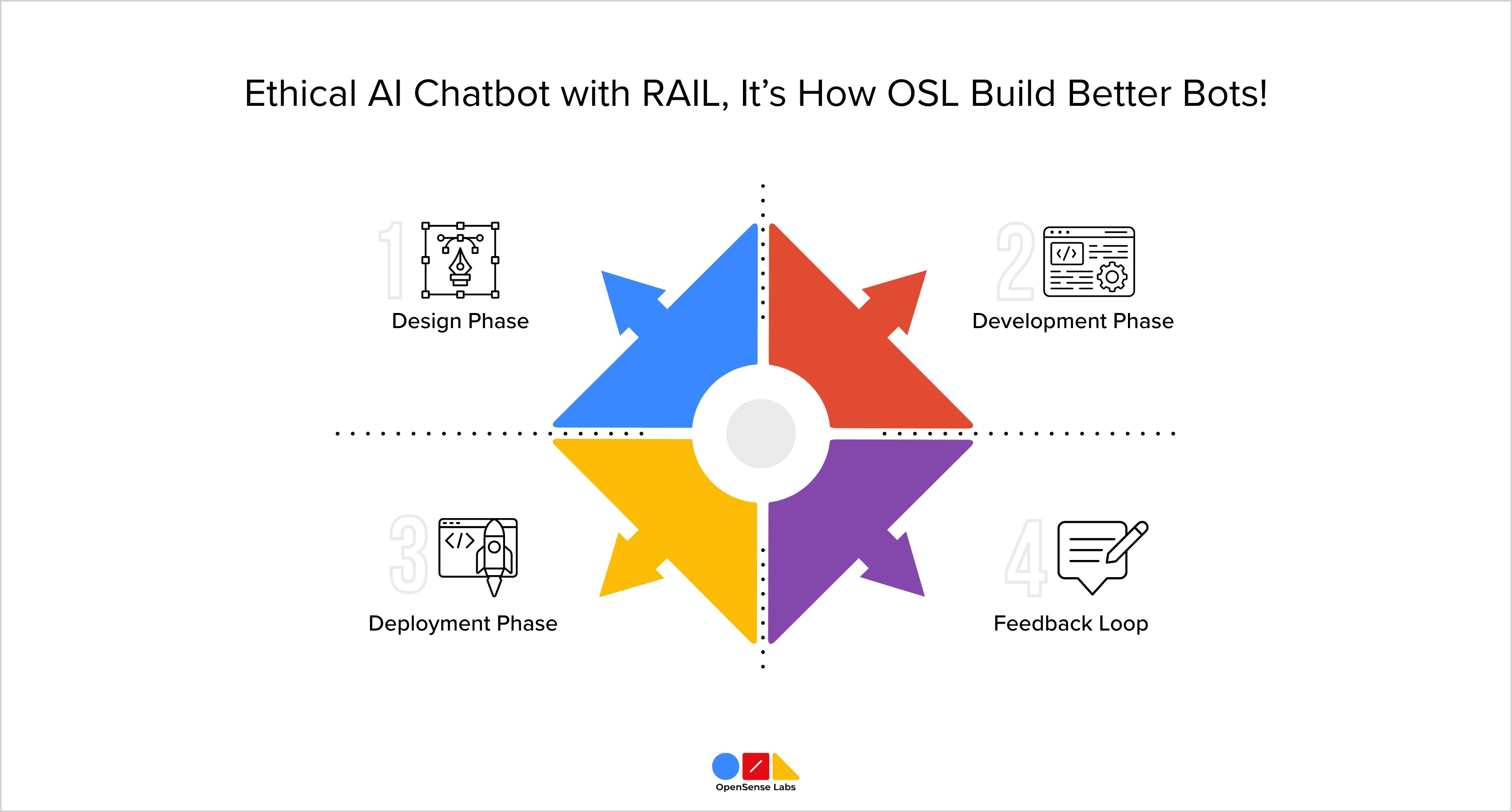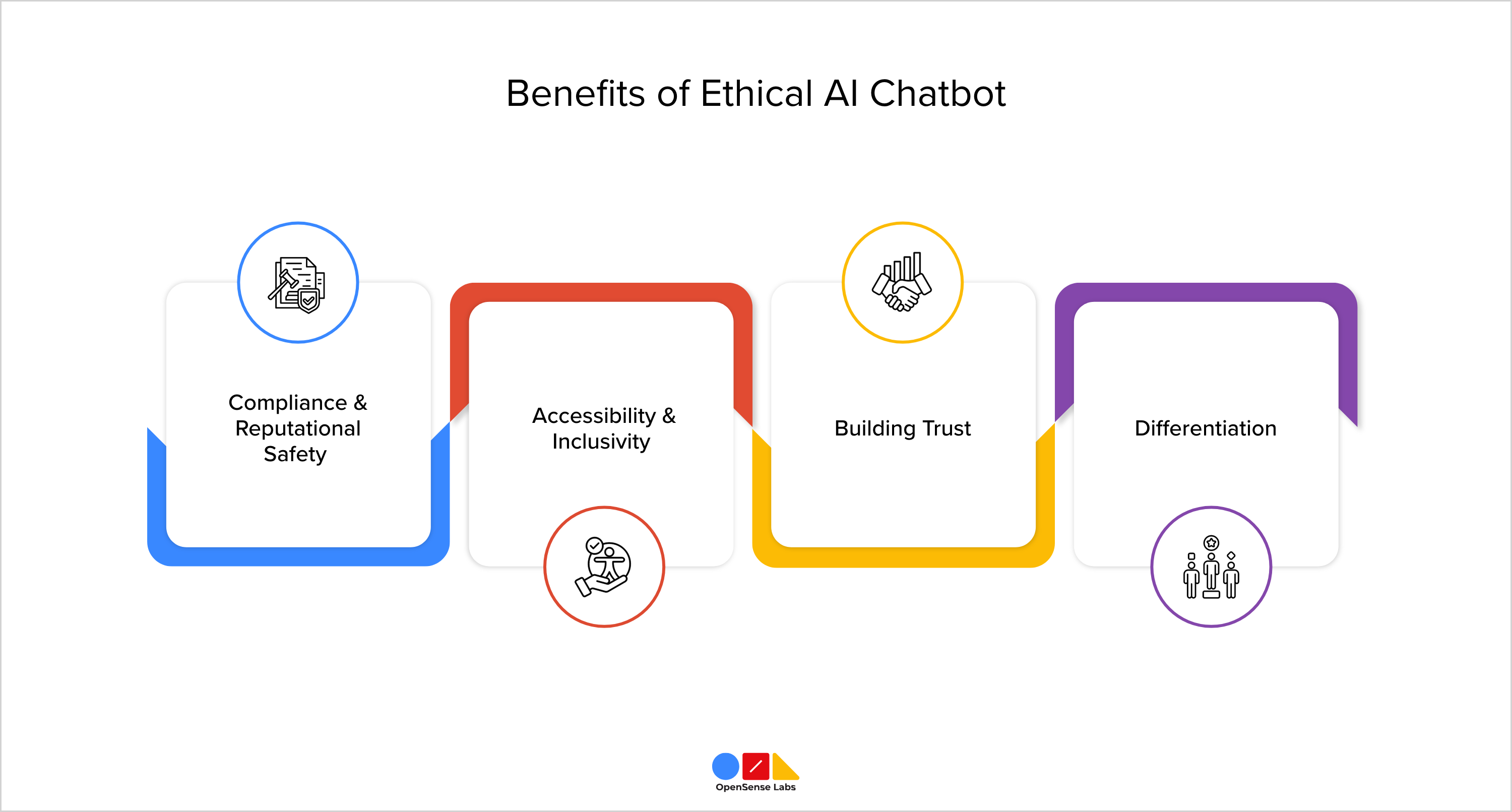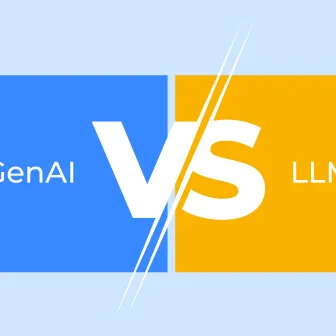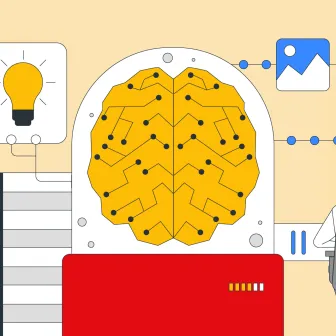Ethical AI Chatbot: Implementing the RAIL Framework at OSL
In today’s digital era, Ethical AI chatbot are transforming industries, from customer service to healthcare and human resources.
However, with their growing adoption comes the risk of biased, unsafe, or unclear responses that can erode trust and lead to legal or reputational issues.
At OSL, we believe that AI must be more than just intelligent; it must be responsible. That’s why we integrate the RAIL framework, developed by Responsible AI Labs, into our client chatbots. This ethical scorecard evaluates AI outputs across eight dimensions.
In this blog, we’ll walk you through how we apply the RAIL framework at every stage of chatbot development, ensuring ethical, high-quality interactions that build trust, drive compliance, and reduce risk.
By embedding RAIL into our process, we ensure our chatbots deliver not just accurate but ethically sound interactions. Want the same for yours?
Now let’s take a look at how OSL seamlessly brings all these ethical dimensions together!
Ethical AI Chatbot: RAIL Framework
The RAIL framework is a comprehensive and structured approach designed to assess the ethical quality of AI outputs. It evaluates responses across eight key dimensions such as fairness, transparency, and accountability etc. making it easier for businesses to identify potential risks, ensure responsible AI behavior, and implement ethical practices within their AI systems.
Below, we discuss each of these eight key dimensions of ethical AI chatbots in detail:
Fairness: Fairness ensures that AI responses are unbiased and do not discriminate against or favor any individual or group based on factors like race, gender, age, religion, or socioeconomic background.
In the context of an ethical AI chatbot, this means generating responses that are inclusive and respectful to all users, regardless of their identity or circumstances.
By prioritizing fairness, the ethical AI chatbot promotes equitable treatment, avoids reinforcing harmful stereotypes, and fosters a more just and balanced user experience for everyone interacting with the system.
Safety: Safety focuses on preventing the AI chatbot from generating harmful, offensive, or dangerous content. This includes avoiding misinformation, hate speech, violent language, or advice that could pose physical, emotional, or psychological risks to users.
An ethical AI chatbot must be designed to recognize sensitive topics and respond with caution or redirect the conversation appropriately. By embedding safety measures, the system helps protect users from potential harm, builds trust, and ensures a secure and responsible user interaction.
Reliability: Reliability ensures that the AI chatbot delivers consistent, accurate, and dependable responses across various interactions. It is critical for maintaining user confidence, especially in environments where users rely on the chatbot for important information or support.
An ethical AI chatbot should avoid giving contradictory or misleading answers and must be able to handle similar queries in a uniform manner. By upholding reliability, the system builds trust, enhances user satisfaction, and reinforces the credibility of the organization behind the technology.
Transparency: Transparency involves providing users with clear insight into how the AI chatbot operates, including how it generates responses, what data it uses, and any limitations it may have. By being open about the decision-making process, the AI fosters greater trust and understanding.
This could include explaining why certain suggestions are made or disclosing when a response is AI-generated. Transparency empowers users to make informed decisions and ensures accountability, which is essential in building ethical and trustworthy AI systems.
Privacy: Privacy is centered on protecting user data and ensuring that all personal or sensitive information shared with the AI chatbot is handled responsibly.
This involves adhering to strict data protection regulations such as GDPR or HIPAA, minimizing data collection, and ensuring secure storage and processing.
An ethical AI chatbot must not misuse, share, or retain user information without explicit consent. By prioritizing privacy, the system respects user boundaries, builds confidence, and upholds the ethical standards expected in digital interactions.
Accountability: Accountability ensures that there are clear processes in place to track, audit, and take responsibility for the AI chatbot’s actions and decisions. This means being able to identify who is responsible when the system makes an error or produces unintended outcomes.
Ethical AI systems should include mechanisms for logging interactions, reviewing decision logic, and enabling corrective measures when needed.
By promoting accountability, organizations can maintain control over their AI tools, demonstrate ethical integrity, and ensure that human oversight remains a core part of the AI lifecycle.
Inclusivity: Inclusivity ensures that the AI chatbot is designed to be accessible and usable by a wide range of users, regardless of their abilities, backgrounds, or cultural contexts.
This involves supporting features like multilingual communication, compatibility with assistive technologies (e.g., screen readers), and sensitivity to different social norms and values.
An ethical AI system should not exclude or alienate any group but rather strive to create a welcoming and respectful experience for all. By embracing inclusivity, the chatbot becomes a tool that truly serves everyone, promoting digital equity and broader user engagement.
User Impact: User Impact focuses on the overall effect the AI chatbot has on users, prioritizing their experience, satisfaction, and well-being. This means designing interactions that are helpful, respectful, and emotionally considerate, avoiding frustration, confusion, or harm.
An ethical AI chatbot should aim to add real value to the user’s journey, whether by providing accurate information, empathetic support, or seamless service.
By carefully evaluating how users feel and respond to their interactions, organizations can ensure the chatbot remains a positive, supportive, and user-centric tool.
ALSO CHECK OUT
1. Agentic AI Dynamics: Future of Data Retrieval
2. Explainable AI Tools: SHAP's power in AI
3. AI Chatbot: Crafting with Precision & Personality
4. AI Fairness: A Deep Dive Into Microsoft's Fairlearn Toolkit
These dimensions are vital in business contexts. For instance, in HR, fairness prevents biased responses about employee policies. In healthcare, safety ensures the accuracy of medical information. Unlike traditional AI metrics focused solely on accuracy, RAIL prioritizes ethical quality, aligning AI with societal values and business needs.
| Dimension | Business Relevance |
|---|---|
| Fairness | Prevents bias in HR or customer-facing chatbots, ensuring equitable treatment. |
| Safety | Avoids harmful outputs, critical in healthcare or legal applications. |
| Reliability | Ensures consistent responses, building trust in financial or customer service bots. |
| Transparency | Clarifies AI decision-making, enhancing user trust in complex processes. |
| Privacy | Protects sensitive data, crucial for compliance in regulated industries. |
| Accountability | Enables the correction of errors while maintaining responsibility in automated systems. |
| Inclusivity | Supports diverse users, improving accessibility in global or varied user bases. |
| User Impact | Enhances user experience, fostering loyalty and satisfaction. |
Ethical AI Chatbot: OSL’s Approach to Responsible AI
At OSL, we embed the RAIL framework into every stage of chatbot development from initial design to final deployment to ensure our solutions prioritize trust, regulatory compliance, and risk mitigation, ultimately driving better outcomes for our clients.
The Responsible AI Workflow
Our workflow ensures ethical considerations are embedded at every step:
Design Phase: During the design phase, we proactively identify potential ethical risks such as biased language, privacy vulnerabilities, or accessibility gaps and incorporate safeguards to address them from the start.
This includes setting clear ethical objectives, choosing inclusive training data, and designing user interactions that are transparent, fair, and respectful.
By building these considerations into the foundation, we ensure our chatbots are aligned with ethical principles before a single line of code is written.
Development Phase: In the development phase, we integrate the RAIL API to actively evaluate chatbot responses in real-time. This allows us to set predefined thresholds for ethical quality across all eight dimensions such as fairness, safety, and reliability.
Responses that fall below these standards are flagged or restructured automatically. This continuous evaluation ensures the chatbot consistently meets ethical expectations as it learns and evolves.
Deployment Phase: During the deployment phase, we continuously monitor the chatbot’s performance against the RAIL framework’s eight ethical dimensions. Real-world interactions are analyzed to detect any drift in behavior, bias, or response quality.
Based on these insights, we make proactive adjustments such as refining response patterns, updating data inputs, or fine-tuning thresholds to ensure the chatbot consistently upholds ethical standards and delivers a reliable, user-centric experience over time.
Feedback Loop: We establish a robust feedback loop where user input and RAIL evaluation scores work together to guide ongoing enhancements. User feedback helps uncover real-world issues such as unclear responses, perceived bias, or usability challenges, while RAIL scores provide quantitative insights into ethical performance.
Together, they inform continuous updates to the chatbot’s behavior, ensuring it evolves responsibly and maintains high ethical standards over the long term.
This approach helps clients build trust with users, comply with regulations like the EU’s AI Act, and reduce risks associated with AI errors or misuse.

Ethical AI Chatbot: Real-Time Scoring of AI Responses Using the RAIL API
A cornerstone of our approach is real-time evaluation of chatbot responses using the RAIL API. Each response is scored across the eight RAIL dimensions, with weights assigned based on the use case (e.g., fairness might be weighted higher in HR applications). A weighted score is calculated, and if it falls below a threshold, say 7.0 out of 10, the response is automatically regenerated using RAIL feedback to address deficiencies, such as improving fairness or clarity.
This process ensures that only ethically sound responses reach users, enhancing both the quality and responsibility of interactions. It goes beyond checking for accuracy, focusing on the broader ethical impact of each response.
It means your chatbot can do more than just provide correct answers; it can reflect your brand's values with every interaction. Let us help you build AI you can trust.
Let’s explore some real-world applications of this approach!
Ethical AI Chatbot: Leave & Holiday Policy Use Case
Consider our Leave & Holiday Policy Chatbot, designed to help employees navigate their leave entitlements. When a user asks, “How many vacation days do I get?” the chatbot generates an initial response: “You get 20 vacation days per year, but this may vary based on your position and tenure.”
Before delivery, the RAIL API evaluates this response, assigning scores like:
| Dimension | Score | Reason |
|---|---|---|
| Fairness | 6.5 | Mention of “position and tenure” could imply unequal treatment. |
| Safety | 9.0 | No harmful content detected. |
| Reliability | 8.5 | Response is generally consistent with policy data. |
| Transparency | 7.0 | Could clarify how variations are determined. |
| Privacy | 8.0 | No sensitive data exposed. |
| Accountability | 7.5 | Traceable but could include contact for further queries. |
| Inclusivity | 6.0 | Lack of guidance for diverse employee groups. |
| User Impact | 8.0 | Informative, but could be more user-friendly. |
If the weighted score is below 7.0, the system regenerates the response by incorporating feedback. A revised response might be: “Typically, employees receive 20 vacation days per year.
The exact number depends on factors like position and length of service. For details, check your employment contract or contact HR.” This scores higher in fairness and inclusivity, ensuring an ethical and user-friendly interaction.
ALSO CHECK OUT
1. Create and Integrate: CKEditor 5 Plugin in Drupal 11
2. Free Learning Content Management System: Best 10 List For 2025
3. Headless CMS vs Traditional CMS: What's The Difference?
4. Ecommerce And Data Analytics: Increase Your Sales
Ethical AI Chatbot: Why This Matters to Our Clients
Integrating RAIL into our chatbots delivers significant benefits:
Compliance & Reputational Safety: As new regulations such as the EU’s AI Act come into play and global attention on AI practices grows, ethical AI has become essential; it is now a legal and strategic requirement.
By aligning chatbot actions with the RAIL framework, we assist in meeting regulatory standards and industry best practices. This approach not only shields clients from possible legal repercussions and data breaches but also protects their brand image by showing a solid commitment to responsible AI.
Accessibility & Inclusivity: Our chatbots are created to cater to a broad and varied user audience by including features like support for multiple languages, compatibility with screen readers, and designs that adapt to different devices.
These improvements guarantee that people with disabilities, along with users from various languages and cultural backgrounds, can interact with the chatbot effortlessly.
By integrating accessibility and inclusivity into the main experience, we expand the reach and effectiveness of our solutions while adhering to ethical and legal requirements for digital fairness.
Building Trust: Trust is the basis of all successful user interactions. By making sure our chatbots communicate clearly, respond justly, and work securely, we build a sense of reliability and respect in every interaction.
These ethically sound exchanges not only boost user confidence but also improve the bond between our clients and their customers, resulting in greater engagement, satisfaction, and lasting loyalty.
Differentiation: In the current competitive environment, being seen as a brand that is responsible for AI provides a significant market edge. By implementing ethical AI practices using the RAIL framework, our clients distinguish themselves as innovative, reliable, and socially aware.
This enhances their brand reputation and draws in customers and partners who prioritize ethics, transparency, and fairness, making responsible innovation a crucial differentiator.
These benefits are especially critical in sectors like HR, finance, and healthcare, where trust and compliance are non-negotiable.

OSL offers tailored AI chatbot solutions with responsible AI at their core. Our standard service includes RAIL framework integration, ensuring your chatbot meets the highest ethical standards. Whether you aim to enhance customer service, streamline internal processes, or deliver innovative user experiences, our team is ready to help.
Key Takeaways
- Responsible AI is essential for ethical, trustworthy AI systems.
- The RAIL framework evaluates AI outputs across eight dimensions, ensuring ethical quality.
- OSL embeds RAIL into every stage of chatbot development, prioritizing trust and compliance.
- Real-time scoring with the RAIL API ensures only ethical responses reach users.
- Clients benefit from enhanced compliance, accessibility, trust, and market differentiation.
By prioritizing responsible AI, OSL builds chatbots that not only perform but also inspire confidence and trust.
Subscribe
Related Blogs
GenAI vs LLM: What’s the Real Difference?

In recent years, artificial intelligence has gained immense popularity, particularly on social media. Picture this: You're…
Agentic AI Dynamics: Future of Data Retrieval

In a world of ever-growing data, finding the right information at the right time can feel like searching for a needle in a…




